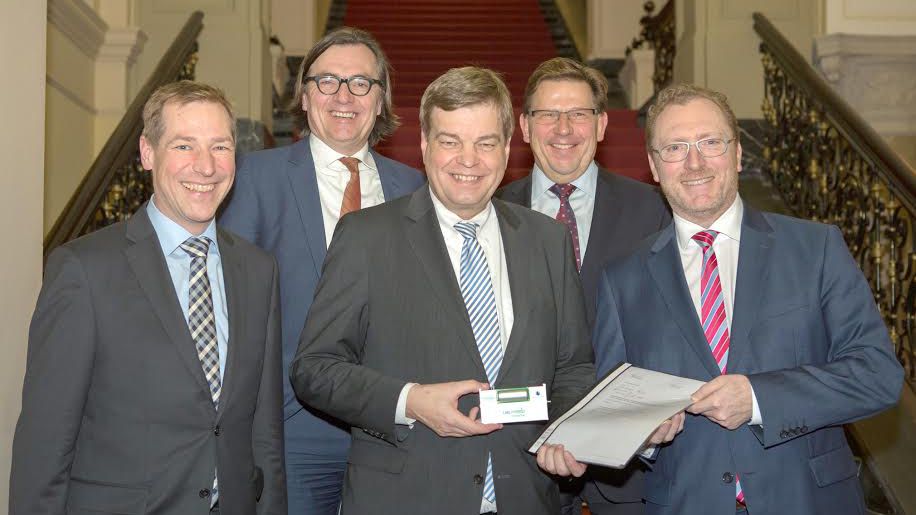Federal Minustry of Transport Infrastructure Promotes Becker Marine Systems

Enak Ferlemann, the Parliamentary Secretary at the German Federal Ministry of Transport and Digital Infrastructure, presented to Becker Marine Systems GmbH&Co. KG a grant notification for funding in the 7-figure range of an overall concept for the alternative supply of energy to ships at ports. As a result, the world’s first special containers of their kind (LNG PowerPacs®) will be deployed aboard container ships. The grant is being provided within the framework of the Mobility and Fuel Strategy of the German Federal Government, with the use of liquefied natural gas (LNG) being fostered as an alternative fuel for maritime applications.
“During layovers at port the power for container ships is currently being supplied by onboard auxiliary diesel engines using fuel oil (Marine Gas Oil, MGO). By doing so, ships account for the majority of harmful emissions at ports. With LNG PowerPacs® we are creating a modern, environmentally-friendly, safe and economical option for supplying power based on LNG to container ships during layovers at port.“ (Henning Kuhlmann, Managing Director, Becker Marine Systems)
The LNG PowerPac® is a compact unit the size of two 40-foot containers, intelligently combining a gas-powered generator with an output of 1.5 Megawatts and an LNG tank in a limited amount of space. Once a container ship is moored, the first thing is to place the LNG PowerPac® on board via the port terminal’s locally available, standardized loading equipment (such as gantry cranes, ship-to-shore cranes, van carriers) to provide energy to the onboard power supply during the vessel‘s layover at port. Compared to operation of the ship‘s auxiliary engines, this represents a decisive reduction.
As part of the planned pilot project, for the first time ever container ships will be supplied power by LNG PowerPacs® during layovers at the Port of Hamburg. “The energy requirements of container ships depend on the size of the vessel and the length of time they spend at port,” said Max Kommorowski (Director LNG Hybrid, Becker Marine Systems). Ralf-Thomas Rapp (Director LNG Hybrid, Becker Marine Systems) added: “An LNG PowerPac® is equipped with a 20-foot LNG ISO tank. The quantity of 8.2 tons of LNG provided in this way enables an efficient supply of energy on board for up to 30 hours.”
For ships spending a longer time at port in Hamburg there is a cascading option, i.e. two tank containers arranged on top of each other for each LNG PowerPac®. This ensures a continuous supply of power for up to 60 hours. However, two LNG PowerPacs® can also be operated in tandem on board a ship. Tandem operation means that two LNG PowerPacs® arranged side by side are able to supply up to 3 Megawatts of power to ships with a greater demand for power.
“By funding the LNG PowerPac® project, the Federal Government is promoting the use of LNG as an alternative fuel at seaports. We are thus implementing the recommendations of the Federal Government’s mobility and fuel strategy. The idea is to make apparent the advantages of the fuel of the future, liquefied natural gas or LNG, across systems in selected regional demonstration and pilot projects. By using LNG, the emission of nitrogen oxide can be almost completely eliminated when compared to conventional diesel engines. Also with respect to greenhouse gasses, LNG has a significantly lower footprint.” (Enak Ferlemann, Parliamentary Secretary at BMVI)
The LNG PowerPac® was chosen by the BMVI as a lighthouse project for a specific funding measure, because the added value being strived for was able to be demonstrated in a particularly advanced way compared to existing solutions for alternative power supply.
• “Cable-free” power supply of container ships: Flexible LNG PowerPac® as an integrated “isolated solution“ for the supply of energy on board
• The use of this modern technology should make supplying power to container ships during layovers at port more environmentally-friendly, safer and more efficient (state-of-the-art technology of the LNG PowerPac® replacing old auxiliary diesel engines)
• Improved handling via quick and flexible connection option of the compact power supply unit via standardized loading equipment such as gantry cranes, etc.
• Integrated into the existing container loading structure at the ship’s stern – no time-consuming connecting procedure via a cable management system
• The output generated by LNG PowerPacs® matches the voltage of the onboard electrical system and can be controlled by onboard electronics with no additional transformers and frequency converters required
• Independence from costly shore power infrastructure: No adjustments of the harbor infrastructure is required for the use of the special containers and no additional costs for the terminal operator.
The products and services herein described in this press release are not endorsed by The Maritime Executive.
